Exploring Squirrel Odor Preferences and Attractants
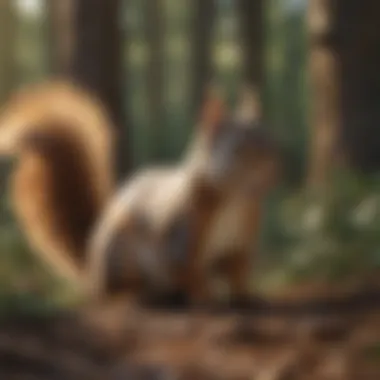
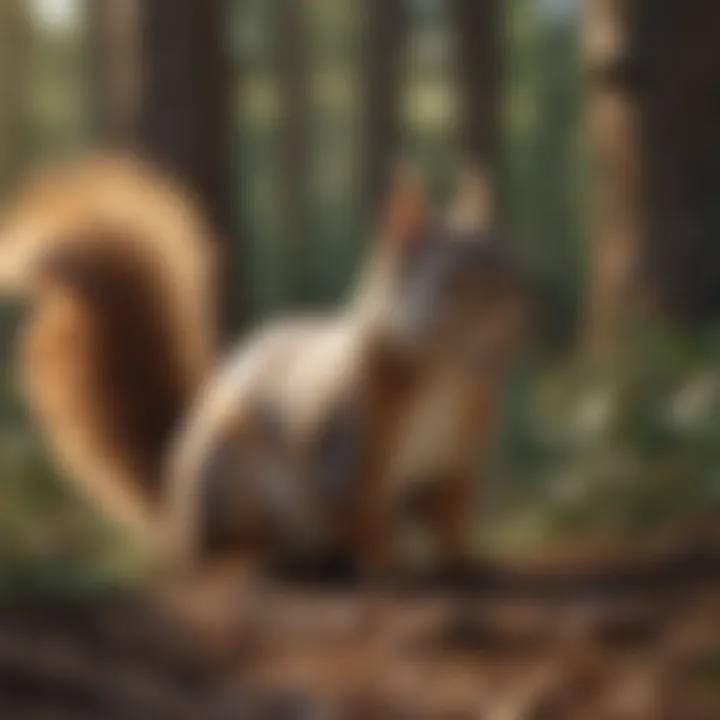
Intro
Squirrels are more than just playful creatures inhabiting parks and backyards. Understanding their behavior, particularly regarding odor preferences, can provide valuable insight into their ecology and interactions with human environments. This article explores the various attractants that lure these animals, examining scent as a significant factor in their feeding habits and social interactions.
Understanding the Pest
Squirrels, belonging to the family Sciuridae, are small to medium-sized rodents. Often recognized by their bushy tails and agile movements, they adapt well to diverse habitats.
Identification
Identifying squirrels often involves discerning their different species. The most common types include the Eastern gray squirrel, fox squirrel, and red squirrel. These animals exhibit various physical traits, such as color variations, size, and tail characteristics. Understanding these differences helps homeowners determine which squirrel species may infest their areas.
Life Cycle
Squirrels have a fascinating life cycle. They generally breed twice a year, producing a litter of three to five young. The nests, known as dreys, are often found in trees. Young squirrels depend on their mothers for food and protection during the initial months of life. The timeline of their development showcases an essential aspect of their life cycle:
- Birth: Squirrels are born blind and hairless.
- Weaning: They begin to eat solid food around six weeks.
- Independence: By three months, they start foraging on their own.
Understanding the life cycle of squirrels is crucial for pest management strategies, especially during breeding seasons when they may seek food and shelter near human dwellings.
Scent Attraction
Squirrels rely heavily on their sense of smell to identify food sources and communicate with one another. They exhibit preferences for specific odors, which can influence their behavior significantly.
Dietary Preferences
Dietary choices in squirrels are often shaped by scent. Commonly, they are attracted to foods rich in fats, such as nuts, seeds, and fruits. The appeal of these food items is not simply about nutrition; the aroma plays a pivotal role in drawing their attention.
Role of Pheromones
Squirrels also produce pheromones that help convey messages related to territory and mating. These chemical signals can communicate reproductive status and alert other squirrels of potential threats. Knowledge of these pheromones can be beneficial for understanding squirrel behavior in urban settings.
Aromatic Substances
Certain substances naturally attract squirrels. For instance, vanilla has been reported to hold a particular allure for them. This tendency can be instrumental when developing traps or bait for pest control.
"By understanding what attracts squirrels, homeowners can adapt their strategies for managing these animals effectively."
Pest Prevention Strategies
As awareness of squirrel behaviors expands, so does the ability to mitigate unwanted issues related to their presence. There are practical methods to prevent encounters with squirrels.
Environment Modification
Adjusting the environment can deter squirrels from frequenting specific areas. Here are some tips to modify surroundings:
- Remove food sources: Bird feeders and pet food should be kept indoors or squirrel-proofed.
- Secure trash cans: Use lids that squirrels cannot open.
- Eliminate hiding spots: Trim trees and shrubs that may serve as nesting sites.
Physical Barriers
Implementing physical barriers is another effective strategy. Fencing and mesh nets can create obstacles that prevent squirrels from accessing gardens or attics. Choosing materials durable enough to withstand squirrel activity is essential for success.
Control Methods
If squirrels become a consistent problem, control measures may be necessary. Evaluating the options available can help in addressing infestations effectively.
Chemical Control
Chemical methods, such as repellents, may provide temporary relief. These products are designed to emit odors that squirrels find unpleasant. Always check local regulations regarding their usage to ensure compliance.
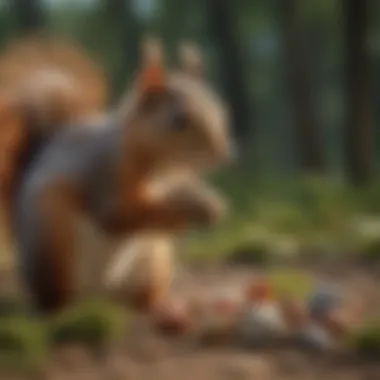
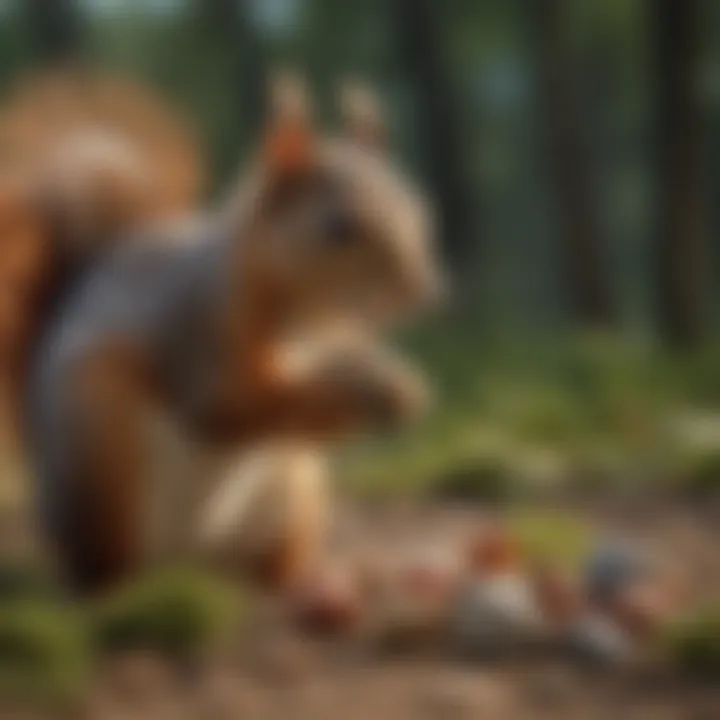
Biological Control
Biological methods involve introducing natural predators or competing species that can diminish squirrel populations. However, care should be taken to assess ecological balance before implementing these measures.
Preamble to Squirrel Behavior
Understanding squirrel behavior is crucial in exploring factors that influence their interactions with the environment. Squirrels demonstrate different behaviors driven by their ecological needs, and smell plays an integral role in those interactions. By examining their behavioral patterns, we can gain insights into how odors act as attractants or deterrents, thus influencing their dietary and territorial choices.
Knowledge of squirrel species is essential since behavior can greatly vary even among closely related species. Each species has adapted to its environment in unique ways. For instance, the Eastern gray squirrel typically occupies urban areas, while the red squirrel is more commonly found in forests. Recognizing these differences allows for a more effective assessment of how each species interacts with scent, enhancing our understanding of their behavior.
Understanding Squirrel Species
Squirrels encompass a variety of species, each exhibiting distinct characteristics. The Eastern gray squirrel, native to North America, is perhaps the most recognized. It thrives in both wooded areas and urban landscapes, a trait that has enabled it to coexist with human populations. Their adaptability to various environments allows them to exploit different food sources, thus shaping their odor preferences.
Conversely, the red squirrel, found in coniferous forests, tends to show a stronger aversion to human influence. This species focuses primarily on a diet of seeds and nuts, which influences its attraction to natural scents found in its habitat. The differences in scent preference between these species could shed light on their ecological roles and interactions.
The Role of Smell in Animal Behavior
Scent is critical in the behavioral ecology of squirrels. Animals rely on smell for various reasons, such as finding food, tracking predators, or communicating with others of their kind. For squirrels, olfaction assumes a central role in foraging and territorial marking. Their ability to discern subtle differences in scent helps them locate food sources and avoid potential dangers.
Increased emphasis on smell can also be observed in social interactions. Squirrels use scent trails to mark their territories, allowing them to communicate their presence to others. This signaling can deter rival squirrels and establish dominance without physical confrontations.
Understanding the dynamics of scent communication enhances our insight into how squirrels navigate their ecosystem and establish social hierarchies. Scent preferences, influenced by breed and environment, are essential components of their survival.
In summary, delving into squirrel behavior through the lens of scent offers valuable insights into their interactions and ecological roles. By analyzing different species and the impact of smell on their actions, we can develop a comprehensive understanding of this intriguing animal, paving the way for further exploration into their attractants and preferences.
Scent-Driven Dietary Preferences
Scent plays a critical role in the dietary choices of squirrels. Understanding their scent-driven dietary preferences is essential for multiple reasons. Firstly, it reveals how squirrels interact with their environment, facilitating their survival and success in various habitats. Secondly, this knowledge can contribute to effective pest management strategies by identifying food sources that attract these animals. Lastly, it sheds light on the ecological framework, enhancing the understanding of food webs involving squirrels as both consumers and prey.
Preferred Food Sources
Squirrels exhibit distinct preferences for food driven by their sense of smell. They are omnivores, meaning they consume a variety of food types. Commonly preferred food sources include nuts, seeds, fruits, and even fungi. Nuts, particularly acorns and walnuts, emit specific scents that signal ripeness and nutrient availability, attracting squirrels. When determining food preferences, they rely heavily on olfactory cues. This ability is not only for locating food but also for distinguishing between edible and non-edible items.
Furthermore, certain flowers and fruits carry scents that appeal to squirrels during specific seasons, encouraging them to forage in various locations. For instance, the sweet smell of ripe berries will draw them in, making these focal points of their dietary habits. In urban settings, they may also be attracted to human food scraps that possess strong odors.
Impact of Seasonal Changes
Seasonal changes significantly influence the scent profiles available to squirrels. During spring and summer, there is an abundance of fresh growth, and the smell of blooming plants and ripening fruits prevails. This makes it easier for squirrels to locate food. However, as seasons transition to fall and winter, available food sources change. The aroma of decaying leaves and winter berries can become more pronounced, affecting squirrel foraging behavior.
In particular, as winter approaches, squirrels rely more on stored food. They depend on their keen sense of smell to locate buried nuts. Research indicates that squirrels are quite adept at remembering the scent markers of their cache locations. This seasonal adaptability showcases their sophisticated interaction with the environment and how scent preferences shift with changes in availability.
"The connection between scent and dietary preference in squirrels is a dynamic interplay of biology and ecology that deserves deeper exploration."
Finale
Gaining insight into the scent-driven dietary preferences of squirrels helps frame their natural behavior within broader ecological contexts. By understanding what draws them to certain food sources, one can develop strategies that minimize human-animal conflict, especially in urban areas where squirrels notably thrive.
Chemical Compounds of Interest
Understanding the chemical compounds that attract squirrels is vital to comprehending their behavior and dietary habits. These compounds influence not just what they eat but also how they interact with their surroundings. This section emphasizes the significance of specific aromas and chemicals that manipulate squirrel preferences and choices in urban and natural settings.
Natural Food Aromas
Squirrels possess a keen sense of smell, which they utilize to detect food sources. Natural food aromas play a crucial role in guiding squirrels to fruits, nuts, and other edible items. For instance, the scent of acorns and hazelnuts is often cited as desirable among these animals. The release of essential oils from these food sources impacts their feeding behavior profoundly.
Different species of squirrels show varied preferences for specific food aromas.
- Eastern Gray Squirrels favor sweet scents, particularly those associated with ripening fruits.
- Fox Squirrels seem more attracted to nutty aromas, aligning with their diet that often includes various seeds and nuts.
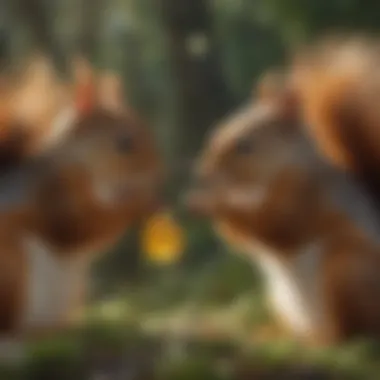
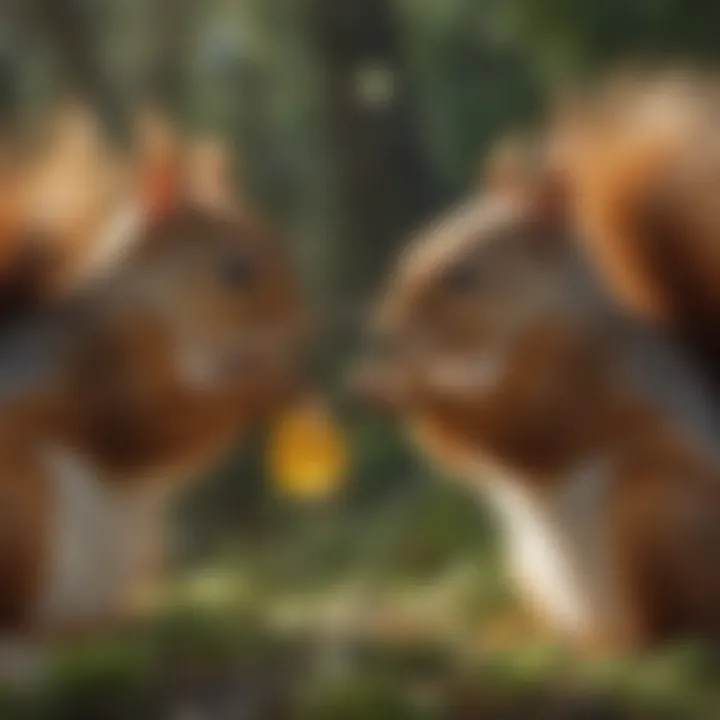
These aromas also vary based on the habitat, impacting the availability of food fragrance in urban versus rural settings. Shifts in environment, such as urbanization, can affect how strongly these natural food aromas are detected by squirrels.
Synthetic Attractants in Urban Settings
The interaction of squirrels with synthetic attractants has garnered attention, especially in urban settings. Pesticides, fertilizers, or even artificially flavored products can present certain scents that appeal to squirrels. Some urban planners have noted that these chemicals can lead to unintended consequences, where squirrels are drawn towards human-made environments looking for food, thus increasing potential human-wildlife conflicts.
Certain synthetic compounds often imitate natural food aromas. This imitation can result in strong, effective attractants, aiding in understanding squirrel behaviors. However, there are ethical implications involved in using synthetic attractants in pest management. The goal is to strike a balance between repelling squirrels effectively while minimizing harm to non-target species.
Research indicates that while synthetic attractants can direct squirrel activity, the long-term effects on their health must be considered.
In summary, both natural food aromas and synthetic substances significantly shape squirrel behavior. Knowledge of these chemical compounds helps in devising effective strategies for both wildlife conservation and urban planning. The evolving urban landscapes continue to challenge squirrels, making understanding their olfactory cues an important area of study.
Role of Pheromones in Squirrel Behavior
Understanding the role of pheromones in squirrel behavior is essential to comprehending how these creatures interact with each other and their surroundings. Pheromones serve as chemical signals that convey important information regarding territory, reproductive status, and social hierarchy. By studying these pheromones, researchers can gain insights into how squirrels communicate and how their behaviors are influenced by these scents.
Understanding Pheromone Interaction
Squirrels, like many other mammals, rely on pheromones to establish social connections and communicate. The scent released by a squirrel can indicate various states, such as readiness to mate or the marking of a territory. This can trigger responses in other squirrels, leading to social behaviors like attraction, avoidance, or aggression.
In urban settings, the interaction with pheromones can change. Urban squirrels often contend with other species, which can alter their use of scent signals. They may adapt their pheromone production based on environmental stressors, competition, and availability of resources. The ability to interpret these hormonal messages is crucial for survival, especially in densely populated areas.
Some studies indicate that female squirrels are particularly sensitive to specific pheromones emitted by males. This sensitivity can guide reproductive choices, leading them to select partners based on the chemical cues those males release. Researchers often analyze the chemical composition of these pheromones to understand what compounds are most effective in eliciting responses from other squirrels. This area of inquiry is gaining traction, with researchers frequently innovating new methods to analyze pheromone interactions in a more detailed manner.
Communicative Roles of Scent
Scents play a significant communicative role in the lives of squirrels. In addition to pheromones, various odors indicate the presence of food or potential threats. The ability to discern between friend and foe through scent enhances their chances of survival. For example, when a squirrel detects the scent of a predator, it may exhibit alert behavior, allowing it to escape danger.
Furthermore, scent helps in establishing and maintaining territories. Male squirrels often mark their territory with urine or other secretions that contain pheromones. This not only communicates to other squirrels that the territory is occupied but also conveys the health and vitality of the individual, which can deter rivals.
Key Takeaways:
- Pheromones are vital for communication among squirrels.
- Squirrels adapt their use of pheromones based on environmental changes.
- Scent marking is a critical component of their territorial behavior.
Understanding these aspects of squirrel pheromone behavior offers unique insights into their adaptations and survival mechanisms. As urban landscapes grow more complex, the role of scent in squirrel life remains a rich field for further research and understanding.
Scent Preferences and Territorial Behavior
Scent plays a significant role in the behavior of squirrels. Understanding how squirrels use smell for territoriality offers valuable insights into their interactions with the environment and other species. Their reliance on odors is not merely instinctual but also an adaptation that enhances their survival. By investigating scent preferences, we can learn about their ecosystem roles and how to manage their populations effectively.
Markers of Territory
Squirrels are known to establish territories using distinct scent markers. These markers help define their boundaries and communicate their presence to other squirrels. The primary method involves the secretion of pheromones from glands located on their feet and cheeks. When squirrels scratch or rub their bodies against tree trunks or branches, they leave behind distinctive scent signals that can be detected by others.
- Scent Marking Behavior: Squirrels often engage in scent-marking rituals. This can vary between species. Grey squirrels tend to use visual cues along with scent, while fox squirrels may rely more heavily on odor.
- Vocalizations: Alongside olfactory markers, squirrels may use vocal sounds to reinforce their territorial claims. These sounds can alert intruders to their presence and convey their readiness to defend their territory.
Understanding these markers is crucial for those interested in wildlife management or pest control. By recognizing these scents, homeowners can better anticipate squirrel behavior around their properties and choose effective prevention methods.
Interactions with Other Species
Squirrels, like many animals, do not exist in isolation. Their scent preferences can influence interactions with other species, both predator and prey. The presence of other animals can shift the behavior of squirrels regarding territory and resource allocation.
- Predator Avoidance: Squirrels use scent to assess potential threats. The smell of predatory species may cause them to modify their patterns of movement or feeding. When they detect a particular scent associated with predators, they may flee or retreat to safer areas.
- Competing Species: The presence of other species also affects how squirrels interact with their environment. If competing species share similar scents or food sources, squirrels may change their feeding habits. This could lead to a shift in territory, affecting their usual behaviors and patterns.
Understanding these interactions highlights the complexity of ecological relationships and the importance of scent in the wildlife world. These dynamics are especially relevant for homeowners looking to maintain a balanced environment around their homes, recognizing the significant role that odors play in managing local wildlife.
"Scent is not just a means of attracting or repelling; it shapes the very fabric of interactions among species in the wild."
Overall, the study of scent preferences and territorial behavior in squirrels reveals the nuanced role that smell plays in their survival. By recognizing how these animals use scent to navigate their world, we can better understand their behavior and develop effective strategies for coexistence.


Influence of Environmental Factors
Understanding the influence of environmental factors is crucial for comprehending how squirrels interact with their surroundings, especially regarding their scent preferences. Environmental elements affect the availability and type of scents that squirrels can encounter. Different habitats offer unique scent profiles that can attract squirrels. Urbanization has brought significant changes to the natural world, altering the sensory landscape and consequently squirrel behavior.
Effects of Urbanization on Scent Availability
Urbanization modifies the availability of scents that squirrels rely on. In cities and suburban areas, the natural environment is disrupted. Natural scents from plants, trees, and organic matter are often replaced or diminished by artificial scents from human activity. For instance, the introduction of synthetic materials, pollution, and food waste changes how odors disperse and are perceived in an urban context.
Key points to consider include:
- Reduction of natural food scents: Urban areas may lack the diversity of smells found in forests or rural settings, impacting squirrels' ability to find food.
- Altered foraging behavior: Squirrels may adapt their foraging strategies due to fewer natural scents, relying more on human food sources that release different odors.
- Increased competition: In an urban setting, squirrels compete with other wildlife and pets for food, which can intensify the need to rely on scent cues.
Natural Habitat and Scent Profiles
In contrast, natural habitats provide a rich array of scents that play a vital role in squirrel behavior. Each ecosystem has distinct aromatic substances generated by flora, fauna, and decomposing organic matter.
Some critical aspects include:
- Diversity of scents: Areas with rich biodiversity such as forests, grasslands, or wetlands offer varied scents that attract squirrels to particular food sources.
- Seasonal changes: Different seasons produce different scents due to the flowering of plants or the ripening of fruits. This variation can guide squirrels to optimal food sources at different times of the year.
- Health of the habitat: A well-maintained natural habitat typically has a robust scent profile that supports healthy squirrel populations. Conversely, habitat degradation can lead to diminished scent markers and in turn affect squirrel behavior.
"Urban settings can significantly distort the natural scent landscape, pushing squirrels to adapt in often unseen ways."
Understanding these environmental influences can provide useful insights into squirrel behavior for homeowners and pest management professionals alike. This information is not only important for ecological studies but also for anyone looking to manage interactions with these animals in residential areas.
Implications for Pest Management
Understanding squirrel odor preferences has important implications for pest management. Squirrels can cause significant damage to gardens, homes, and attics. By knowing the types of odors that attract or repel these animals, effective control strategies can be developed.
Odor-Based Deterrents
One effective approach in managing squirrel populations is the use of odor-based deterrents. Certain smells are known to deter squirrels from entering specific areas. These odors can be both natural and synthetic. Natural deterrents include peppermint oil, cinnamon, and garlic. Synthetic products also exist, often formulated to mimic these natural scents.
Benefits of Using Odor-Based Deterrents
- Non-Toxic: Many odor-based solutions are eco-friendly and safe for both animals and humans.
- Targeted Approach: Deterrents can be applied specifically in hotspots, such as bird feeders or gardens.
- Ease of Application: Most of these products are simple to apply, whether as sprays or granular forms.
Incorporating these deterrents into a pest management plan can help reduce squirrel encounters without needing to rely on more harmful methods like traps.
Integrating Odor Knowledge in Strategies
Expanding on the understanding of squirrel scent preferences, integrating this knowledge into pest management strategies can enhance effectiveness. Using a combination of attractants and repellents can create a balanced approach. For example, areas can be treated with attractive foods to lure squirrels away from problem locations while simultaneously using repellents in those areas.
Considerations for Effecive Implementation
- Monitor Effectiveness: Continual assessment of deterrent effectiveness should be undertaken. If a deterrent is failing, adjustments must be made.
- Behavioral Study: Observing squirrel reactions to different odors can help refine strategies over time.
- Environmental Changes: Factors such as seasonality or urbanization can affect squirrel behavior. Strategies must be flexible to adapt to these changes.
Employing scent knowledge in pest management can lead to more humane and efficient control measures.
Culmination and Future Research Directions
Understanding the preferences of squirrels for various odors provides vital insights into their behavior and ecology. This section offers a synthesis of the research findings and discusses future avenues of inquiry.
Summary of Findings
Throughout the investigation, several significant aspects of squirrel odor preferences emerged. First, the dietary habits of squirrels are closely linked to their ability to detect and respond to specific scents. The squirrels show a marked preference for certain natural food aromas, preferring nuts and fruits that emit strong, appealing smells. Urbanization seems to impact available scents, shaping their dietary choices even further. The research also established that pheromones play a critical role in communication, signaling reproductive status and territorial boundaries. Ultimately, these findings underscore the complexities of squirrel interactions with their environments, influenced by both natural and synthetic scents.
Recommendations for Further Studies
To build on existing knowledge, several areas require deeper exploration:
- Longitudinal Studies: Investigating seasonal changes in scent preferences over extended periods could yield valuable information about adaptability in scent attraction.
- Comparative Species Research: Comparing the scent preferences of different squirrel species may highlight evolutionary adaptations.
- Impact of Urban Environments: A deeper understanding of how urban scents affect squirrel behavior will be vital, especially as urban habitats expand.
- Behavioral Reaction Studies: Observing squirrels in controlled settings with specific odors could clarify their responses and preferences.
Future research can also integrate technology, such as scent-tracking devices or odor discriminating sensors, to gain more precise measurements of scent impact on squirrel behavior. These studies will enhance pest management strategies and broader ecological understanding, benefiting both wildlife conservation efforts and urban pest control initiatives.
The findings from these research directions can lead to innovative and humane strategies for managing squirrel populations, aligning ecological balance with community interests.







